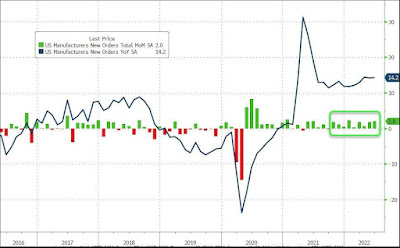*** denotes well-worth reading in full at source (even if excerpted extensively here)
Economic and Market Fare:***** Persistent Inflation Scares The Fed
Economist @graceblakeley says raising interest rates won't help control inflation, because inflation is being driven by rising energy prices. Grace is also clear the idea of a wage price spiral is nonsense - workers demanding wages in line with inflation need to be supported #GMB pic.twitter.com/DTQZS35fOU
— Saul Staniforth (@SaulStaniforth) August 4, 2022
We wouldn't find out for several years that labor market really did take a turn for the worse in the middle of 2019. The Fed "pause" quickly became Fed rate cuts because Est Survey wasn't capable of picking up inflection.
— Jeffrey P. Snider (@JeffSnider_AIP) August 6, 2022
But HH Survey had.https://t.co/EH7guxTKpo pic.twitter.com/5E4eteh1H1
...MPC forecasting longer lasting deeper recession than GR lasts 7qtrs vs 5down -7.1% vs -6.1%
— Professor Danny Blanchflower economist & fisherman (@D_Blanchflower) August 4, 2022
2022Q4 - 2024Q2
Q1 -1.01%
Q2 -1.26
Q3 -2.07
Q4-1.24
Q5 -0.97
Q6 -0.52
Q7 -0.04
Total -7.11
2008Q2 -2009Q2
Q1 -0.45%
Q2 -1.49
Q3 -2.01
Q4 -1.80
Q5 -0.31
Total -6.06%
Wow
...WTI futures price has fallen -$31.45 (-26%) from $122.11 to $90.66 since June 8.
— Art Berman (@aeberman12) August 4, 2022
Price is at the lowest level since early February 2022.
Price has followed a pattern of lower lows and lower highs.#OOTT #oilandgas #WTI #CrudeOil #fintwit #OPEC #Commodities pic.twitter.com/cmgBAjKD5p
The IMF is run by assholes.
— Brad Johnson (@climatebrad) August 5, 2022
title: How Europe Can Protect the Poor from Surging Energy Prices
text: "Governments should allow the full increase in fuels costs to pass to end-users to encourage energy saving and switching out of fossil fuels."https://t.co/a6qOeKTUJU@IMFNews
1:
(not just) for the ESG crowd:
Other Fare:
Tweet Vids of the Week:
Natural born goalie! 😂🐱⚽️🐾 pic.twitter.com/H6ome7Whex
— Fred Schultz (@FredSchultz35) August 2, 2022
Contrarian Perspectives
Extra [i.e. Controversial] Fare:
*** denotes well-worth reading in full at source (even if excerpted extensively here)
Regular Fare:
Tweet Vids:
Eva Vlaardingerbroek and Mark Steyn - worrisome... pic.twitter.com/ANl7I7a0Ow
— Wittgenstein (@backtolife_2023) August 3, 2022
Unsustainability / Climate Fare:
407ppm CO₂ = 3.5C
— Uncovering the Truth About Climate | Risk Assessor (@MarkCranfield_) July 23, 2022
420ppm CO₂ = 4C
James Hansen, Nutshell, 2018... pic.twitter.com/xabUnF1sdX
COVID Fare:
Read everything by eugyppius; el gato malo; Mathew Crawford; Steve Kirsch; Jessica Rose!
Paul Alexander, Berenson, Chudov, Lyons-Weiler, Toby Rogers are also go-to mainstays; a list to which I have added Andreas Oehler, Joey Smalley (aka Metatron) and, Julius Ruechel; Denninger worth staying on top of too for his insights, and especially his colorful language; and Norman Fenton; Marc Girardot; plus Walter Chesnut (on twitter); new additions: Sheldon Yakiwchuk and Aaron Kheriarty; I will of course continue to post links to key Peter McCullough material, and Geert Vanden Bossche, and Robert Malone, and Martin Kulldorff, and Jay Bhattacharya, and Sucharit Bhakdi, and Pierre Kory, and Harvey Risch, and Michael Yeadon, and John Ioannidis, and Paul Marik, and Tess Lawrie, and Zelenko, and Dolores Cahill, and [local prof] Byram Bridle, and Ryan Cole, and…
Dr William Makis @MakisMD now tracking 13 Canadian doctors that have recently died suddenly
— 🇨🇦 Liar.com deems me unacceptable (@SeenAndForeseen) August 3, 2022
"Vast majority of doctors will get their 4th and 5th 💉 this summer and fall. Sadly, I expect many more deaths to come."https://t.co/4dooPdcINo pic.twitter.com/7BB7n62hOW
CO-VIDs of the Week:
The Trozzi Report Episode 1 Part 3 | All Cause Excess Mortality & VI AIDS
"Excess deaths are through the roof; and anyone who thinks it's not the 'vaccine' is a moron"
Anecdotal Fare:
.... A Winnipeg family says they've been told they may have to wait as long as a year to find out what caused their 14-year-old daughter's death. Talina Rampersad-Husack died suddenly on July 17 in the intensive care unit at the Children's Hospital, her obituary says.
Back to Non-Pandemic Fare:
The People in Hiroshima Didn’t Expect it Either
https://t.co/jKX60OoCOW
— Polina Pomorenko (@PolinaPomorenko) August 4, 2022
We have known for a long time that the Ukrainian military is using civilians as human shields. At least pro-western organisations are starting to pick it up now.
Orwellian Fare:
German journalist Alina Lipp said she was facing three years in prison in her home country for her reporting on crimes committed by Ukrainian forces against civilians.
CaitOz Fare:
Pics of the Week:





















No comments:
Post a Comment